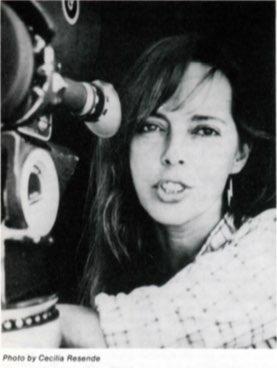Women in Film

This article is reprinted from the brochure 'Festival of films on women' organised by the Vimochana and Bangalore Film Society, India. It is written by Kay Armatage and Linda Beath and was first printed in women and film.
Women have been making films since 1896. In that year, Lumiere was making factual visual records of actual events, and Alice Guy Blache was developing the techniques of fictional film production. By 1910 she had formed her own production company in America and during the course of her career produced 270 silent films.
Ever since then women have been making major contributions to the history and art of the cinema. In some periods they have been less visible than in others: in the 1940's, for example, women made lowbudget movies in Hollywood, used male pseudonyms, left their names off the credits completely. or — remarkably — gave directing credit to their husbands! (What about early Hollywood? Women iVere involved both in front of and behind the cameras (scripting editing, producing directing). See The Parade's Gone 8 / by Kevin Brownlow. G.PJ
Despite formidable obstacles-heavy and awkward early cameras, producers and studio heads who had no faith in a woman's ability to cope with her crew, the myth that women were better at emotions than technology, and the wider social values which placed women behind an apron over a cradle rather than behind a camera on the sound stage-women have continued to make important and innovative changes in the style and scope of filmmaking.

Animation is a facet of filmmaking which was originated and evolved by creative women. Lotte Reiniger, an Austrian woman, is universally credited with developing the idea of making a film, one frame at a time, using silhouette figures. For over fifty-five years she has been the undisputed master of the genre. In 1929, the Brumberg sisters became Russia's pioneer animators; Joy Batchelor, half of the most successful animation team in the world-Halas and Batchelor, renowned for Animal Farm — was responsible for many technical innovations; and in the U.S.A., Mary Ellen Bute experimented with abstract forms of animation in 1930's. Faith Hubely, working in many countries including Canada over the last thirty years, has many award winning films to her credit; Evelyn Lambert, who has worked with Norman McLaren and the National Film Board since the late 1940's, has helped develop important techniques such as pixillation (making inanimate objects seem to move by their own power). However,
while exulting in women's contributions to the art of animation, we must keep these factors in perspective: animation was considered a 'suitable' area for women to work in
because it requires patience but no authority over large casts and crews, and because cartoons and animated films are regarded as almost synonymous with children's films.
In the more established area of live action cinema, women have played a role similar to their functions in the development of the other arts. They have created techniques and genres which deviate from and undercut the traditional forms of cinema. Esther Shub was unable to find raw film stock or camera, so she worked with ready developed f i lm shot by men. By editing these visual tracks from newsreels and documentaries, she created the first compilation film. The Fall of the Romanov Dynasty (USSR, 1927). This is the classic situation of a creative artist working without the proper materials (camera, crew, actors, studio settings, or film stock) and out of such adverse conditions producing a new form whose impact is still being felt. Shub's influence on theatrical newsreels, propaganda films, and the mass of TV programming
is beyond estimation.
Experimental and underground cinema is another important evolution which women can tal« responsibility for. In the avant-garde film, as in the compilation film, women's contribution to the art has grown out of economic necessity. Without the high capital investment involved in the production of commercial films, women found alternative methods of expressing themselves. In the 1940's, Hollywood's era of the star system and the dream factory, Maya Deren opposed the spectacular, commercial formula and replaced it with her personal and poetic dance films and Meshes of the Afternoon, which began the whole New American Cinema movement. Shirley Clarke, Storm de Hirsch, and other independent filmmakers of the 60's further evolved this form.
Besides these impressive contributions, women have been visible over the years in the beginning stages of film movements. Germaine Dulac was making surrealist films about women's problems and marriage six years before the time of Bunuel's La Chien Andalou. Agnes Varda and Vera Chytilova have been prominent in the French and Czech New Wave movements, and the growing Third World and Revolutionary cinemas have a surprising number of women artists.
In the 60's and 70's, there has been a resurgence of women working in all capacities of film production, reversing the trend of the late 40's and 50's to keep women in front of the camera and on the screen. Mai Zetterling, Lina Wertmuller, Elaine May, Nelly Kaplan, and Go Bo Se are working on bigbudget productions with recognized stars; Karen Sperling, Barbara Loden, and Mireille Dansereau make modestly budgeted films; and many women work co-operatively on independent films. The numbers of women working as producers, directors, and f i lm editors, as well as the recognition of their work mark a new stage in the development of world cinema. In addition, women are finding new outlets for their creativity in the media that are inexpensive and easily accessible: videotape and TV. Shirley Clarke has continued her film experimentation
by using closed circuit TV in a theatrical setting-her Video Circus-and many women are welcoming the portable videotape recorder as a useful vehicle for political films.

The history of women's involvement in cinema has always been closely connected with the economic and social climate of the twentieth century. In the periods of women's greatest emancipation, from the turn of the century through the 1930's and again in the 60's and 70's there have been noticeable peaks in the output of women directors. This is not, by any means, a suggestion that women find new talents at these times, but rather an indication that the prevailing social attitudes and the economic situation of the post-war years worked to stifle their creative opportunities. Women's own attitudes towards herself, moreover, reflected and perpetuated the social norms, so that women only very seldom were able to break out of their traditional social roles. We have found our heroes in these women.

